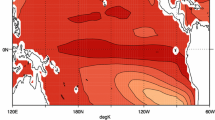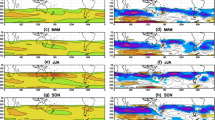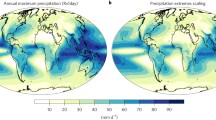Abstract
Based on model output from a multi-model ensemble (MME) of coupled atmosphere-ocean general circulation models, it is shown that prolonged trends in Australian rainfall over the southwest during winter and the monsoonal northwest during summer are associated with trends in the large scale Southern Hemisphere circulation. These trends, in turn, are the result of external radiative forcing, including anthropogenic greenhouse gases, ozone, aerosols and land use change. The MME is used in an analysis of covariance method to separate the internal (natural) variability in the coupled rainfall-atmospheric circulation relationship from influences associated with anomalous external radiative forcing. In both seasons, the leading coupled external mode (singular vector) in the twentieth century runs has rainfall and circulation loading patterns with associated time-series that have statistically significant trends. The associated rainfall loading patterns qualitatively resemble the patterns of observed rainfall trends. The circulation loading patterns reflect the thermal expansion of the tropics and the Hadley Cell. A comparison between similar analyses using the second half of the twenty-first century of the representative concentration pathways (RCP) RCP8.5 and RCP4.5 scenarios show that trends in rainfall and the circulation are projected to continue and intensify under increasing anthropogenic greenhouse gas concentrations. The technique developed here is generally applicable to separate the climate change signal from natural variability in any relevant pair of coupled climate fields.






Similar content being viewed by others
References
An S-I, Wang B (2000) Interdecadal change of the structure of the ENSO mode and its impact on the ENSO frequency. J Clim 13:2044–2055. doi:10.1175/1520-0442(2000)013<2044:ICOTSO>2.0.CO;2
Arblaster JM, Meehl GA (2006) Contributions of external forcings to southern annular mode trends. J Clim 19:2896–2905. doi:10.1175/JCLI3774.1
Cai W, Cowan T (2006) SAM and regional rainfall in IPCC AR4 models: can anthropogenic forcing account for southwest Western Australian winter rainfall reduction? Geophys Res Lett 33:L24708. doi:10.1029/2006GL028037
Catto JL, Jakob C, Nicholls N (2012) The influence of changes in synoptic regimes on north Australian wet season rainfall trends. J Geophys Res Atmos 117:D10102. doi:10.1029/2012JD017472
Collins M et al (2013) Long-term climate change: projections, commitments and irreversibility. In: Stocker TF et al (eds) Climate change 2013: the physical science basis contribution of working group I to the fifth assessment report of the intergovernmental panel on climate change. Cambridge University Press, Cambridge, pp 1029–1136
Eyring V et al (2013) Long-term ozone changes and associated climate impacts in CMIP5 simulations. J Geophys Res Atmos 118:5029–5060. doi:10.1002/jgrd.50316
Flato G et al (2013) Evaluation of climate models. In: Stocker TF et al (eds) Climate change 2013: the physical science basis contribution of working group I to the fifth assessment report of the intergovernmental panel on climate change. Cambridge University Press, Cambridge, pp 741–866
Frederiksen JS, Frederiksen CS (2007) Interdecadal changes in Southern Hemisphere winter storm track modes. Tellus A 59:599–617. doi:10.1111/j.1600-0870.2007.00264.x
Frederiksen JS, Frederiksen CS (2011) Twentieth century winter changes in Southern Hemisphere synoptic weather modes. Adv Meteorol. doi:10.1155/2011/353829
Frederiksen CS, Zheng X (2007) Variability of seasonal-mean fields arising from intraseasonal variability. Part 3: application to SH winter and summer circulations. Clim Dyn 28:849–866. doi:10.1007/s00382-006-0214-9
Frederiksen CS, Frederiksen JS, Sisson JM, Osbrough SL (2011) Australian winter circulation and rainfall changes and projections. Int J Clim Chang Strateg Manag 3:170–188. doi:10.1108/17568691111129002
Frederiksen CS, Zheng X, Grainger S (2014) Teleconnections and predictive characteristics of Australian seasonal rainfall. Clim Dyn 43:1381–1408. doi:10.1007/s00382-013-1952-0
Freitas ACV, Ambrizzi T (2012) Changes in the Austral winter Hadley circulation and the impact on stationary Rossby waves propagation. Adv Meteorol. doi:10.1155/2012/980816
Grainger S, Frederiksen CS, Zheng X (2011) Estimating components of covariance between two climate variables using model ensembles. ANZIAM J 52:C318–C332. http://journal.austms.org.au/ojs/index.php/ANZIAMJ/article/view/3928
Grainger S, Frederiksen CS, Zheng X (2013) Modes of interannual variability of Southern Hemisphere atmospheric circulation in CMIP3 models: assessment and projections. Clim Dyn 41:479–500. doi:10.1007/s00382-012-1659-7
Grainger S, Frederiksen CS, Zheng X (2014) Assessment of modes of interannual variability of Southern Hemisphere atmospheric circulation in CMIP5 models. J Clim 27:8107–8125. doi:10.1175/JCLI-D-14-00251.1
Hendon HH, Thompson DWJ, Wheeler MC (2007) Australian rainfall and surface temperature variations associated with the Southern Hemisphere annular mode. J Clim 20:2452–2467. doi:10.1175/JCLI4134.1
Holton JR (2004) An introduction to dynamic meteorology. Elsevier, Burlington
Hope PK, Drosdowsky W, Nicholls N (2006) Shifts in the synoptic systems influencing southwest Western Australia. Clim Dyn 26:751–764. doi:10.1007/s00382-006-0115-y
Indian Ocean Climate Initiative (IOCI) (2012) Western Australia’s weather and climate: a synthesis of Indian ocean climate initiative stage 3 research. CSIRO and Bureau of Meteorology, Australia
Jones DA, Wang W, Fawcett R (2009) High-quality spatial climate data-sets for Australia. Aust Meteorol Ocean J 58:233–248
Jourdain NC, Sen Gupta A, Taschetto AS, Ummenhofer CC, Moise AF, Ashok K (2013) The Indo-Australian monsoon and its relationship to ENSO and IOD in reanalysis data and the CMIP3/CMIP5simulations. Clim Dyn 41:3073–3102. doi:10.1007/s00382-013-1676-1
Kalnay E et al (1996) The NCEP/NCAR 40-year reanalysis project. Bull Am Meteorol Soc 77:437–471. doi:10.1175/1520-0477(1996)077<0437:TNYRP>2.0.CO;2
Lavender SL, Abbs DJ (2013) Trends in Australian rainfall: contribution of tropical cyclones and closed lows. Clim Dyn 40:317–326. doi:10.1007/s00382-012-1566-y
Meehl GA, Covey C, Delworth T, Latif M, McAvaney B, Mitchell JFB, Stouffer RJ, Taylor KE (2007) The WCRP CMIP3 multimodel dataset: a new era in climate change research. Bull Am Meteorol Soc 88:1383–1394. doi:10.1175/BAMS-88-9-1383
Nguyen H, Evans A, Lucas C, Smith I, Timbal B (2013) The Hadley circulation in reanalyses: climatology, variability, and change. J Clim 26:3357–3376. doi:10.1175/JCLI-D-12-00224.1
Nitta T, Yamada S (1989) Recent warming of tropical sea surface temperature and its relationship to the Northern Hemisphere circulation. J Meteorol Soc Jpn 67:375–383
Pitman AJ, Narisma GT, Pielke RA, Holbrook NJ (2004) Impact of land cover change on the climate of southwest Western Australia. J Geophys Res 109:D18109. doi:10.1029/2003JD004347
Polvani LM, Waugh DW, Correa GJP, Son S-W (2011) Stratospheric Ozone depletion: the main driver of twentieth-century atmospheric circulation changes in the Southern Hemisphere. J Clim 24:795–812. doi:10.1175/2010JCLI3772.1
Pope M, Jakob C, Reeder MJ (2009) Regimes of the North Australian wet season. J Clim 22:6699–6715. doi:10.1175/2009JCLI3057.1
Risbey JS, Pook MJ, McIntosh PC, Wheeler MC, Hendon HH (2009) On the remote drivers of rainfall variability in Australia. Mon Weather Rev 137:3233–3253. doi:10.1175/2009MWR2861.1
Rotstayn LD, Cai W, Dix MR, Farquhar GD, Feng Y, Ginoux P, Herzog M, Ito A, Penner JE, Roderick ML, Wang M (2007) Have Australian rainfall and cloudiness increased due to the remote effects of Asian anthropogenic aerosols? J Geophys Res 112:D09202. doi:10.1029/2006JD007712
Rowell DP, Folland CK, Maskell K, Ward MN (1995) Variability of summer rainfall over tropical north Africa (1906–92): observations and modelling. Q J R Meteorol Soc 121:669–704. doi:10.1002/qj.49712152311
Santer BD, Sausen R, Wigley TML, Boyle JS, AchutaRao K, Doutriaux C, Hansen JE, Meehl GA, Roeckner E, Ruedy R, Schmidt G, Taylor KE (2003) Behavior of tropopause height and atmospheric temperature in models, reanalyses, and observations: decadal changes. J Geophys Res 108:4002. doi:10.1029/2002JD002258
Shi G, Cai W, Cowan T, Ribbe J, Rotstayn L, Dix M (2008) Variability and trend of North West Australia rainfall: observations and coupled climate modeling. J Clim 21:2938–2959. doi:10.1175/2007JCLI1908.1
Simpson IR, Blackburn M, Haigh JD (2009) The role of eddies in driving the tropospheric response to stratospheric heating perturbations. J Atmos Sci 66:1347–1365. doi:10.1175/2008JAS2758.1
Stachnik JP, Schumacher C (2011) A comparison of the Hadley circulation in modern reanalyses. J Geophys Res 116:D22102. doi:10.1029/2011JD016677
Taschetto AS, England MH (2009) An analysis of late twentieth century trends in Australian rainfall. Int J Climatol 29:791–807. doi:10.1002/joc.1736
Taylor KE, Stouffer RJ, Meehl GA (2012) An overview of CMIP5 and the experiment design. Bull Am Meteorol Soc 93:485–498. doi:10.1175/BAMS-D-11-00094.1
Timbal B (2004) Southwest Australia past and future rainfall trends. Clim Res 26:233–249. doi:10.3354/cr026233
Trenberth KE (1990) Recent observed interdecadal climate changes in the Northern Hemisphere. Bull Am Meteorol Soc 71:988–993. doi:10.1175/1520-0477(1990)071<0988:ROICCI>2.0.CO;2
Trenberth KE, Hurrel JW (1994) Decadal atmosphere-ocean variations in the Pacific. Clim Dyn 9:303–319. doi:10.1007/BF00204745
van Vuuren DP et al (2011) The representative concentration pathways: an overview. Clim Chang 109:5–31. doi:10.1007/s10584-011-0148-z
Wang JS, Seidel DJ, Free M (2012) How well do we know recent climate trends at the tropical tropopause? J Geophys Res Atmos 117:D09118. doi:10.1029/2012JD017444
Zheng X, Sugi M, Frederiksen CS (2004) Interannual variability and predictability in an ensemble of climate simulations with the MRI-JMA AGCM. J Meteorol Soc Jpn 82:1–18. doi:10.2151/jmsj.82.1
Zheng X, Straus DM, Frederiksen CS, Grainger S (2009) Potentially predictable patterns of extratropical tropospheric circulation in an ensemble of climate simulations with the COLA AGCM. Q J R Meteorol Soc 135:1816–1829. doi:10.1002/qj.492
Acknowledgments
CMIP5 data is available from http://pcmdi9.llnl.gov. AWAP rainfall data is available from http://www.bom.gov.au/climate/maps. We acknowledge the World Research Programme’s Working Group on Coupled Modelling, which is responsible for CMIP, and we thank the climate modelling groups for producing and making available their model output. For CMIP, the US Department of Energy’s Program for Climate Model Diagnosis and Intercomparison provides coordinating support and led development of software infrastructure in partnership with the Global Organization for Earth System Science Portals. We acknowledge the resources and support of the National Computational Infrastructure at the Australian National University for maintaining the CMIP5 data at the Australian Earth Systems Grid node. J. Sisson provided invaluable assistance in pre-processing the CMIP5 data and in producing the figures. This work was supported by the Australian Government Department of the Environment through the Australian Climate Change Science Program. Comments from P. Lehmann, S. Osbrough and two anonymous reviewers helped to improve this paper.
Author information
Authors and Affiliations
Corresponding author
Rights and permissions
About this article
Cite this article
Frederiksen, C.S., Grainger, S. The role of external forcing in prolonged trends in Australian rainfall. Clim Dyn 45, 2455–2468 (2015). https://doi.org/10.1007/s00382-015-2482-8
Received:
Accepted:
Published:
Issue Date:
DOI: https://doi.org/10.1007/s00382-015-2482-8




